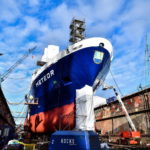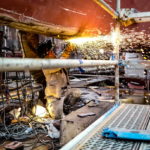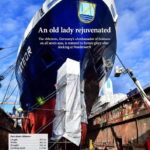The »Meteor«, Germany’s »Ambassador of Science« on all seven seas, is restored to former glory after docking at Norderwerft
The research vessel has covered more than 1.4 million nautical miles since its commissioning in 1986. At the end of[ds_preview] last year, the »Meteor« headed for its home port of Hamburg. Time for extensive conservation of the underwater hull and for work impossible during the research voyages.
After 160,000 operating hours, the four diesel engines were fitted with new cylinder heads and pistons. The steering gear was overhauled and the shaft seal renewed. All the ship’s refrigeration systems have been converted to an environmentally friendly refrigerant. Portholes had to be sealed, ballast tanks checked and preserved and the markings on the two anchor chains renewed. Cabins, mess room and work spaces were partly equipped with new floors and new inventory.
After five weeks of hard work both for the crew and shipyard wherein workers had applied 1,200 l of fresh paint, the »Meteor« featured a brilliant new look when it passed over to the »Open Ship« at Hamburg’s Überseebrücke. Captain Rainer Hammacher: »The ›Meteor‹ is a special ship due to its tradition. This could be felt even during docking time.«
The Meteor’s history including numerous expeditions is currently presented in the International Maritime Museum. Among the exhibits are the wooden mast foot of the first »Meteor« and the bell of the second.
The third »Meteor«, built at the Schlichting shipyard in Travemünde, is operated on behalf of the German Research Foundation (DFG) and the Federal Ministry of Education and Research (BMBF). The missions are coordinated by the »Leitstelle Deutsche Forschungsschiffe« at the University of Hamburg. Briese Research provides the crew and the technical management of the research vessel (98m, 4,280 gt). It can accomodate 30 crew members and 32 scientists.

























